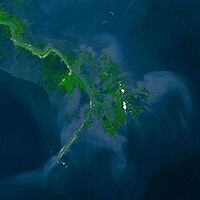
Photo from wikipedia
In this article, based on a flume tank experiment, we attempt to provide some key insights to the depositional process and geomorphological evolution of an experimental alluvial fan dominated by… Click to show full abstract
In this article, based on a flume tank experiment, we attempt to provide some key insights to the depositional process and geomorphological evolution of an experimental alluvial fan dominated by flood events. In the experiment, all boundary conditions were kept constant besides the sediment and water supply in each flood event. The experimental fan formed after 12 flood events. The elevation at the observation points was measured and the geomorphology evolution during the whole experiment was recorded by time-lapsed digital images. It is showed that the depositional process of the experimental fan could be subdivided into three stages, including the sheet flood-dominated stage, the unconfined channel-dominated stage, and the confined channel-dominated stage. The spontaneous evolution of the experimental fan was indicated to be controlled by the continuously occupation of the accommodation space and resulted in the three-layer sedimentary architecture. With the growth of this experimental fan, the increasing rate of fan area and the vertically aggradational rate decreased. Meanwhile, the roughness of the fan edge changed from rapid fluctuation to gradually decrease.
Journal Title: Arabian Journal of Geosciences
Year Published: 2019
Link to full text (if available)
Share on Social Media: Sign Up to like & get
recommendations!